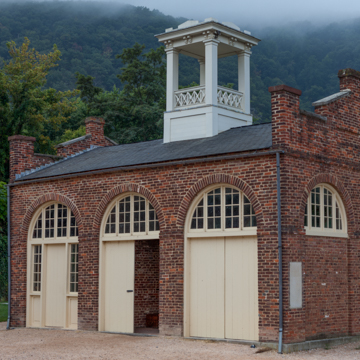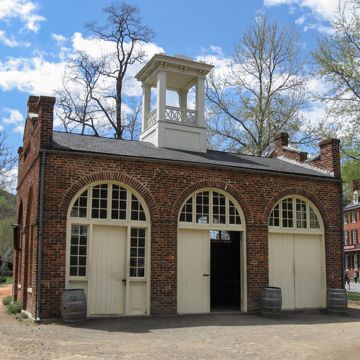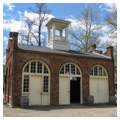You are here
John Brown's Fort (Armory Engine House)
John Brown's Fort is the epicenter of Harpers Ferry's history. Within its walls, abolitionist John Brown and his compatriots took refuge shortly after noon on Monday, October 17, 1859. Marines stormed the building and captured the defenders the next day.
The small brick structure, built as the firehouse, held two engines. Originally located just north of its present site, across Shenandoah Street and inside the armory grounds, it did
John Brown's Fort has a second, lesserknown claim to distinction: it easily takes honors as West Virginia's most peripatetic building, having been moved and rebuilt no fewer than four times. First taken down in 1892, it was shipped to Chicago and rebuilt as a display near the grounds of the 1893 World's Columbian Exposition. When the fair closed, it was dismantled, and its parts were kept in storage for a number of years. Kate Field, journalist and publisher, spearheaded its return to Harpers Ferry, which came to pass in 1895–1896. Although the B&O Railroad transported its components free of charge and offered property close to the original location for the rebuilding, Field preferred a site on Bolivar Heights. There it remained until 1909, the fiftieth anniversary of John Brown's raid. The fort was then moved to the Storer College campus and fitted as a museum. During this rebuilding, soft-fired interior bricks were interspersed with the original hard-fired facing bricks on the exterior walls. The fort consequently acquired a mottled appearance that it has retained. The Historic American Buildings Survey recorded it in 1958, and a decade later, in 1967–1968, it was taken down one more time and reerected at its present and fifth site. The most recent restoration dates from 1976–1977. Although now closer to its original site than it has been since it was first taken away, it is still not quite back where it belongs. Surprisingly, the building is thought to contain most of its original materials, although bricks from John Brown's Fort were among the most popular souvenirs hawked to tourists in Harpers Ferry throughout the late nineteenth and early twentieth centuries.
Writing Credits
If SAH Archipedia has been useful to you, please consider supporting it.
SAH Archipedia tells the story of the United States through its buildings, landscapes, and cities. This freely available resource empowers the public with authoritative knowledge that deepens their understanding and appreciation of the built environment. But the Society of Architectural Historians, which created SAH Archipedia with University of Virginia Press, needs your support to maintain the high-caliber research, writing, photography, cartography, editing, design, and programming that make SAH Archipedia a trusted online resource available to all who value the history of place, heritage tourism, and learning.






